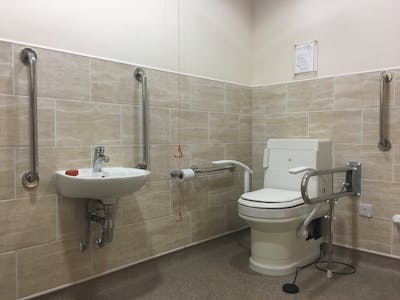Walk-In Shower Cost Guide 2024
Published: 11 April 2024
As we get older, we don’t quite know what exactly is going to happen to us. Well, we have an idea that we start to slow down but at what rate, is the question that we can’t answer.
So we are always trying by all means to prepare for the future to make life easier as we progress.
That will include making adjustments to different areas of our home.
We will be focusing on walk-in showers, and providing a comprehensive guide on the different types of walk-in showers we may want to consider for the future.
.jpg?auto=compress%2Cformat&cs=strip&ixlib=php-1.1.0&s=fc20a023ff19e429a76e5b3972be311b)
And with the growing ageing population in the UK, the need for accessible walk-in bathrooms would be a suitable solution for the elderly and disabled users.
Walk-in showers are one of the safest bathing solution options as they provide individuals with heightened safety features, provide a high level of independence, and comfort.
While the thought of a walk-in shower installation might sound appealing it is also worth noting that the cost of a walk-in shower does vary as you have to consider:
> Size of the bathroom
> User requirements
> Design preferences
> Budget
> Safety requirements
These factors above will determine the price of a walk-in shower. However, the long-term benefits of an accessible walk-in shower can save individual medical costs such as falls and injuries that could occur without the right safety measures in place.
We have compiled research and expert advice and put together an in-depth walk-in shower guide price guide that will give you the factors to consider and the price of walk-in showers.
Understanding your needs and budget
Before getting into the details of a walk-in shower cost we first go into understanding the needs and requirements and then deciding a budget for a walk-in shower.
In this section, we will break down the different types of walk-in showers and essential considerations of the shower and budget planning tips that will help you make informed decisions.
.jpg?auto=compress%2Cformat&cs=strip&ixlib=php-1.1.0&s=cca089325a5e13ef565c60964c601458)
Types of walk-in showers
> Standard walk-in shower (walk-in accessible shower / easy access shower
A standard walk-in shower installation (walk-in accessible shower), is a perfect bathing solution for an individual who wants to enhance their safety within the bathing area.
If an individual is finding it difficult to use their existing shower or bath, then an accessible easy-access shower is the perfect solution, with its low-level access slightly raised (approximately 2-4 inches) slip-resistant tray.
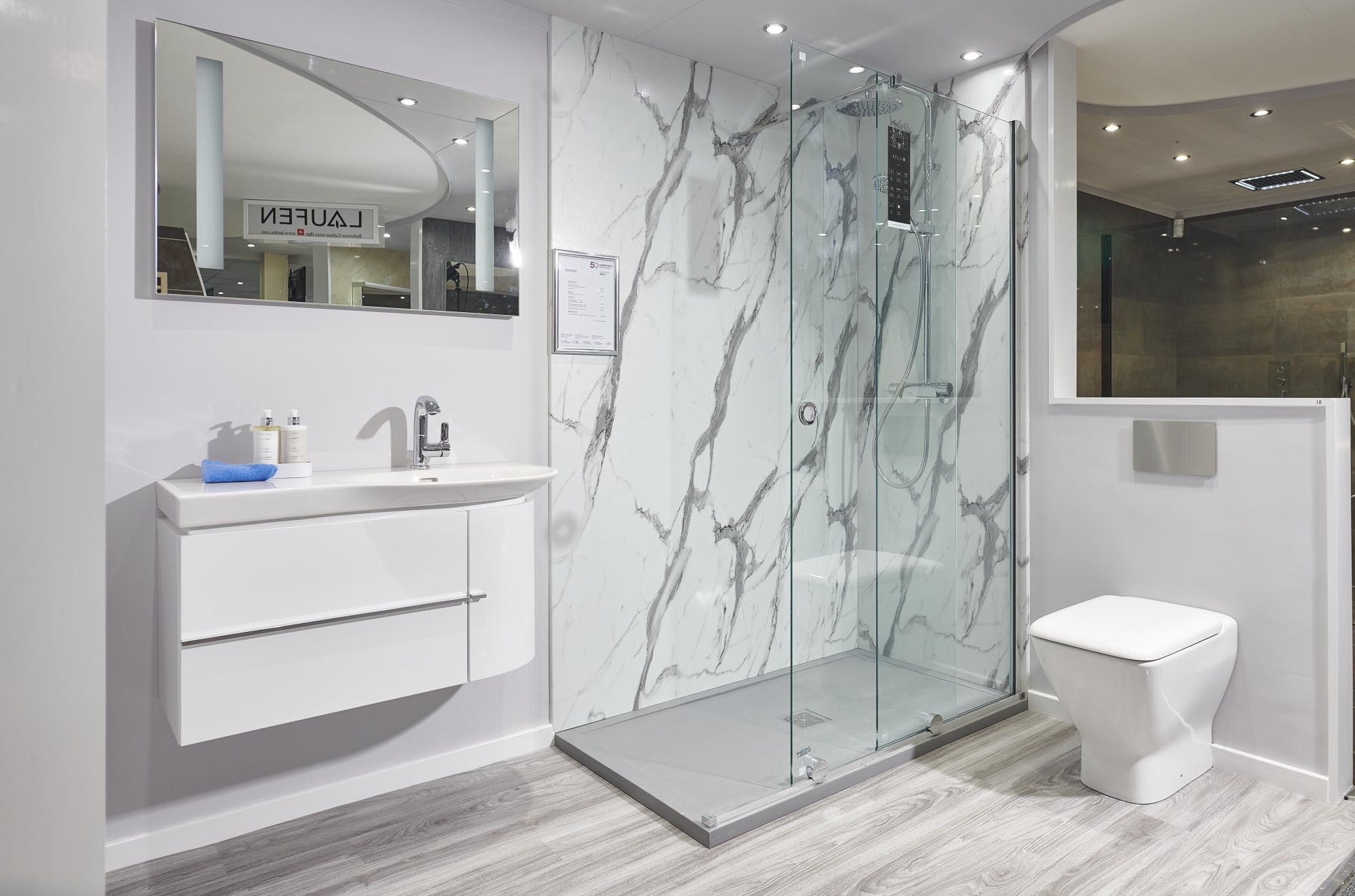
The low-level accessible shower tray distinguishes itself from the rest of the bathroom floor area, allowing a seamless entry into the shower.
This bathing option is certainly suitable for all individuals with accessible requirements who may require little to no assistance transferring in and out of the shower area.
> Barrier-free walk-in shower (Mobility wet room)
Similar to the walk-in accessible shower, the main difference is that the barrier-free bathing shower has complete-level access.
The level-access shower is one of the most appropriate bathroom solutions for an individual with reduced mobility and for those who require a wheelchair, giving them easy access in and out of the shower space.
The anti-slip shower tray has been built into the floor with a strategically placed drainage sloped to allow a proper water flow. They are designed to blend in well with the overall mobility design.
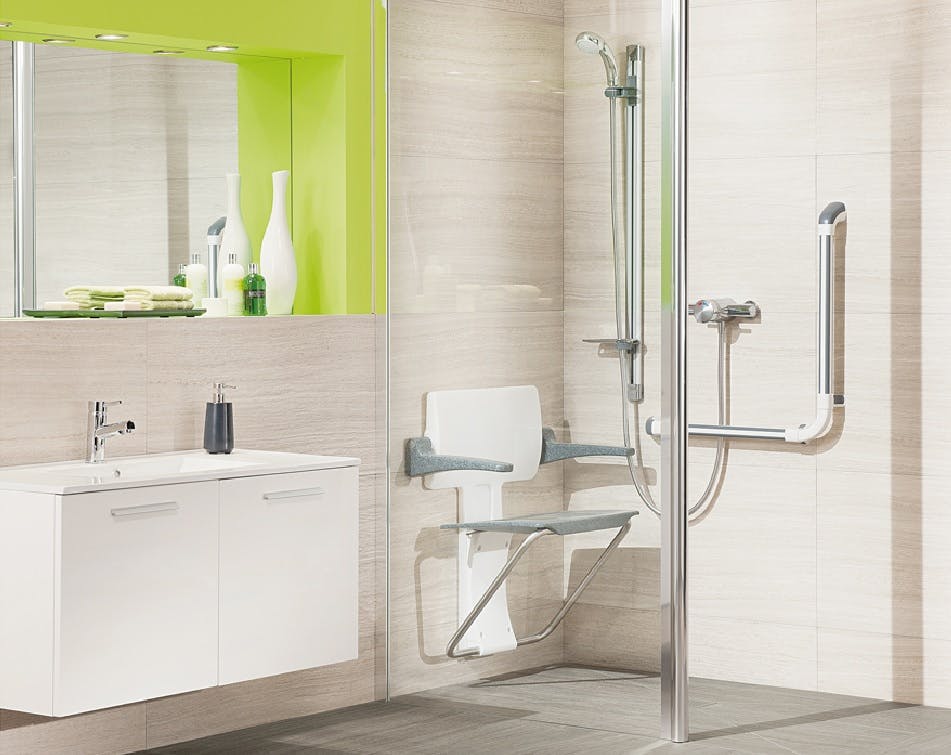
Other features of the level access shower are that it comes with either a shower curtain, half-height doors or a tough partitioned glass screen. All are built to help keep the water under control, within the shower area.
Users have the option to have a seat built as part of the shower or which will allow them to sit down safely whilst using the shower. The options include:
> Bespoke built-in bench
> Fold up chair
> Fixed cushioned shower chair
>Zero-threshold walk-in shower (accessible wet floor shower)
Similar to the barrier-free (level access shower) and zero-threshold walk-in shower (walk-in accessible shower) the zero-threshold walk-in shower is typically an aesthetic design for individuals with accessible requirements.
The design is popular amongst elderly users who want to retain style in their bathroom and stay safe whilst they’re showering.
It is also a welcomed choice for families who have multiple generations living under one roof, meeting all the requirements of the family from design to safety.
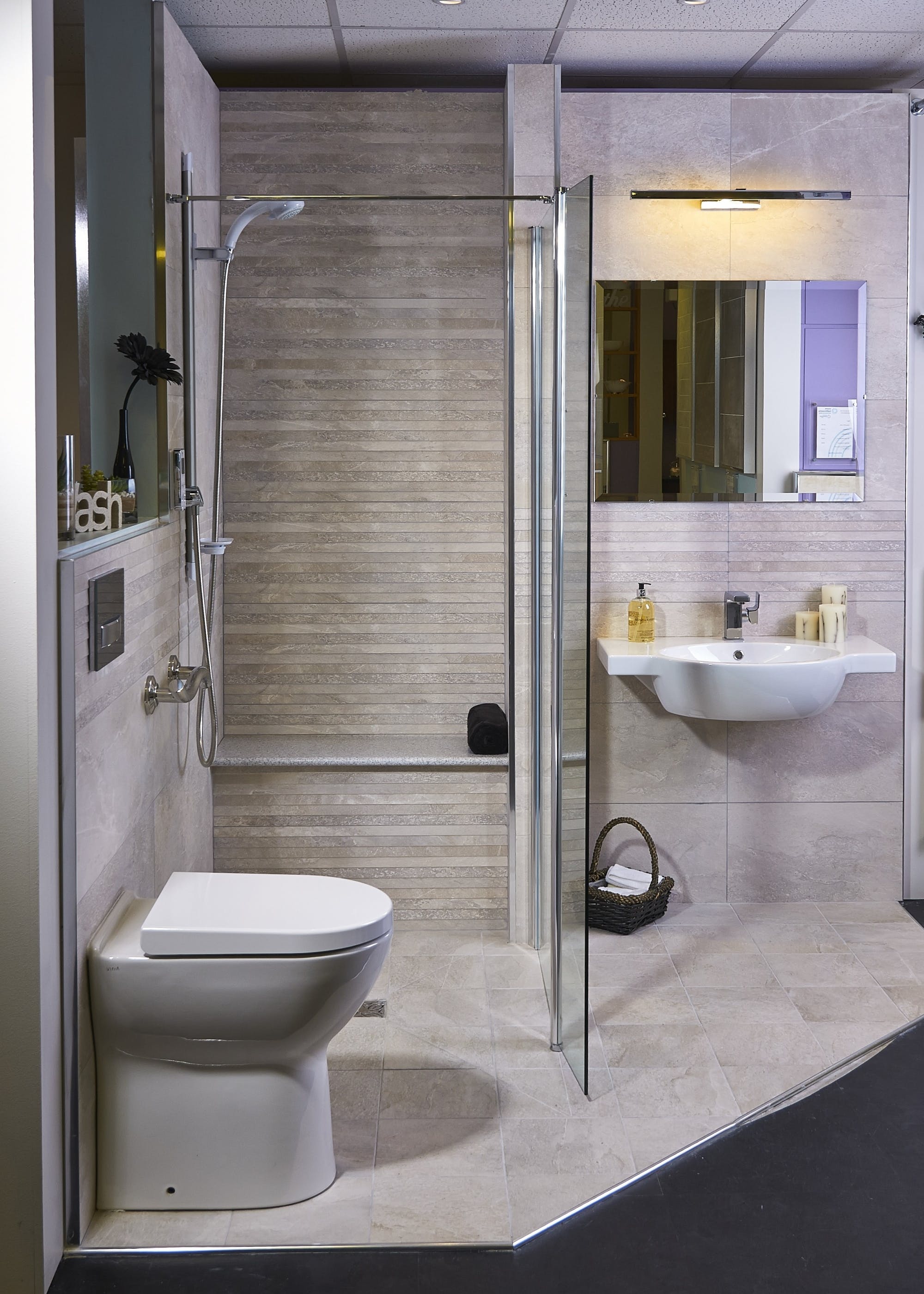
Accessible wet floor showers are purpose-built to meet the needs of the users.
Underneath the nonslip surface is a shower tray. The shower area is then complete with a partitioned glass screen that helps to keep the water under control in one area.
The rest of the entire shower space is fit with anti-slip vinyl flooring, creating an accessible wet floor shower, providing the users with complete peace of mind, and offering a much better showering experience.
Just like the barrier-free shower, they would allow wheelchair users to enter the shower area without obstructions.
The main attraction to this shower solution is the amount of bespoke design modifications individuals can make (as it is designed for - but not to look like an accessible shower), with many accessible bathroom custom options.
> Roll-in shower (disabled shower)
A larger shower option is a popular choice for wheelchair users given its wide access to the shower area helping them to access the shower space with ease.
It is very similar in design to the accessible wet floor shower concept with aesthetically pleasing features fit as part of the design.
.jpg?auto=compress%2Cformat&cs=strip&ixlib=php-1.1.0&s=b7fa7aee79a7401427c148f7b060ccd0)
The key to is that they provide wheelchair users to retain their independence and make their overall daily life easier with a nice, easy-to-use shower area.
Just like the other showering areas, there is a range of seat options that can be fit as part of the wide shower option.
Essential considerations
What the individual has to consider is the level of accessibility or mobility they have and what their needs and requirements would be when it comes to their showering needs.
> Mobility level
The first point is to consider the individual level of independence, and that would include first assessing their strength and balance.
If the user is independent and can stand, then opting for a standard walk-in shower (walk-in accessible shower) will most likely be the best showering solution for the user as they can enjoy an unparalleled shower with complete peace of mind with a slip-resistant tray in place to reduce the risk of them falling and the fittings of accessible bathroom design of their choice.
.jpg?auto=compress%2Cformat&cs=strip&ixlib=php-1.1.0&s=26b88d78e89f4f635685480b27383ca0)
The user may require the assistance of a walking stick then a mobility-level access showering concept could suit them more, as they would still be independent, but this shower has more accessible bathroom features that would ensure their safety, and ease of shower use.
A suitable bathing solution for a wheelchair user is a seamless wide shower entry, also known as a disabled shower with a floor-level access tray or anti-slip vinyl flooring.
As for wheelchair users, it is paramount that their shower space has wide access which allows their chairs in and out of the area smoothly. They will have fitted grab bars that will help them to move from their chair into the shower.
> Transferring assistance
Once the user's mobility level and the most suitable shower for them have been agreed on, the next step would be to decide what accessible features would be a helping hand, to assist them when they are showering or transferring from their wheelchair to a bench.
Grab bars have great accessible features as they can increase the confidence and independence of wheelchair users with limited balance, or decreasing mobility offering reassurance and assistance to shower safely and independently, whether standing or sitting down.
From a safety point of view, they can help with the shower which is a prime location for water and susceptible to slips and falls, grab bars aid the individuals with balance in entering or exiting the shower, reducing the risk of slipping or falling.
> Showering needs
Choosing the right showerhead could be the defining difference in an individual’s showering experience.
A standard showerhead would be difficult for someone who is in a wheelchair or struggles with balance and reduced mobility.
.jpg?auto=compress%2Cformat&cs=strip&ixlib=php-1.1.0&s=94995546c0609a9c2c7de001aecc5d80)
> Additional features
There are more accessible features that can help users with accessible, reduced mobility and wheelchair users to ensure their safety whilst using a walk-in shower.
This may include a fitting anti-slip vinyl flooring, otherwise known as non-slip flooring, around the walk-in shower.
Even though this could increase the cost of a walk-in shower, anti-slip vinyl flooringis the safest bathroom flooring option when it comes to bathroom design, more so for those with mobility or disability needs.
Not only do they reduce slips and falls occurring in the area, additionally they’re also easy to clean and low in maintenance.
Other options could include emergency buttons, mood lighting, or even built-in shelving, these could all have an impact on the price of a walk-in shower.
> Aesthetics
The final essential consideration of an accessible or mobility shower room is the design of the room, and this comes down to the user's preferences.
There is a range of accessible, mobility designs, that users can decide from.
The overall shower design could be fit with modern, traditional, or even luxury fittings.
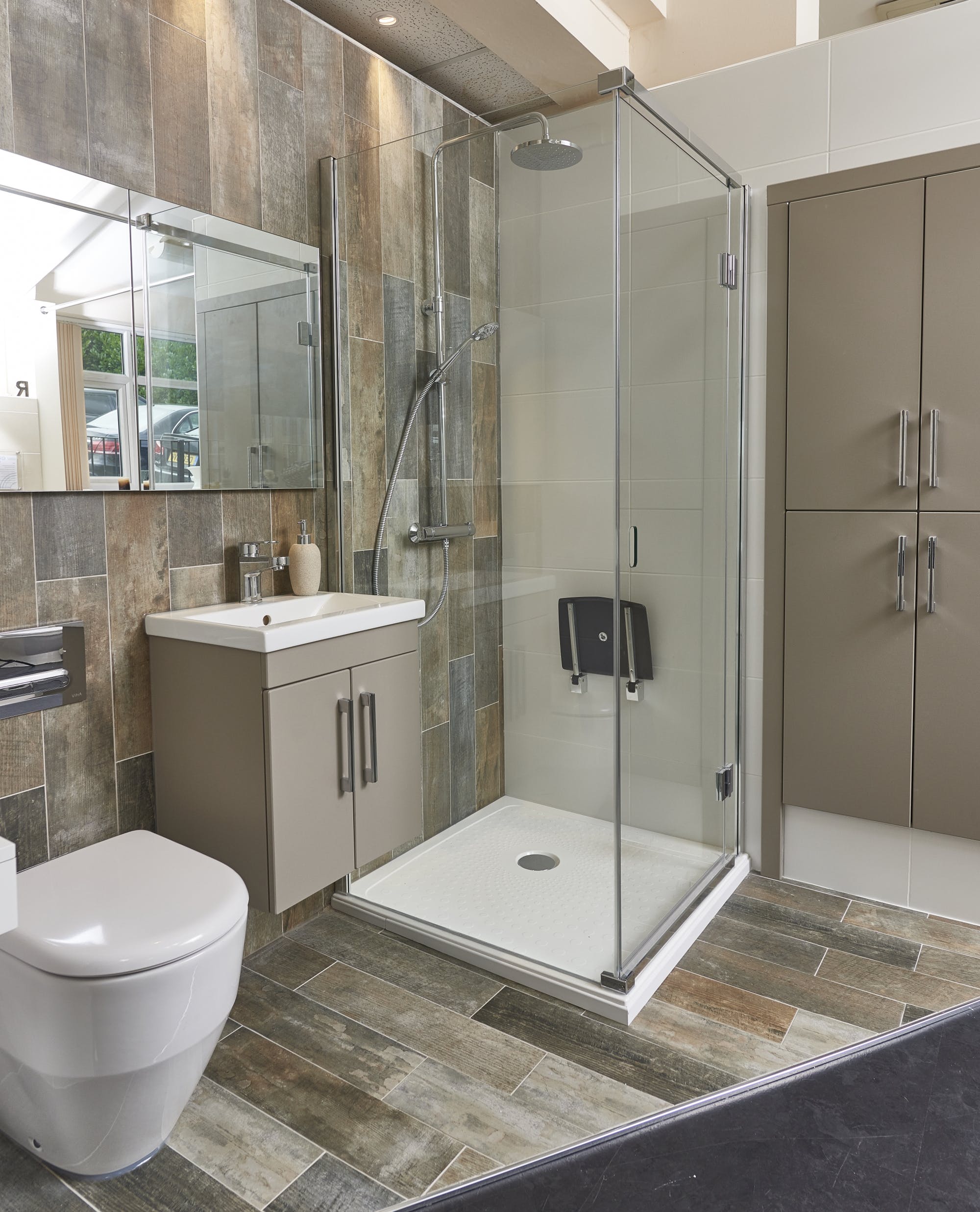
Choosing colour and tiles will compliment the overall shower room design.
We have a team of experts who can help design a new walk-in shower concept that aligns with the user's essentials, needs and requirements, forming part of a full design and fit service.
> Budget planning
The next step of our walk-in shower price guide is to have a look at the budget and plan to finalise the overall walk-in shower cost.
> Set a realistic range
The first thought is to finalise the overall budget of the project for a walk-in shower. That is the foundation of the walk-in shower
Then it would prioritise the essential items before you consider the non-essential items. This will include choosing which type of shower design meets the needs of the individual's mobility level.
Items like grab bars and a seat are essential items if the user's mobility requires them to have one.
Once you have the essentials out of the way, you’ll want to factor in unforeseen costs that the project may offer, it could include the removal of the existing concept in place, plumbing that may need reconfiguring or even unexpected issues that may occur that will cause the refurbishment to rise.
> Material choices
The cost of materials can vary for materials but if individuals are going for a budget-friendly shower room then an acrylic type offers many benefits for the shower as they are durable and affordable and do give a stone or marble look many people desire.
On the other hand, individuals can opt for luxury stone or marble finishes, that can also be used for tiling.
These options can also be customised but they come at a higher cost which can drive up the walk-in shower cost.
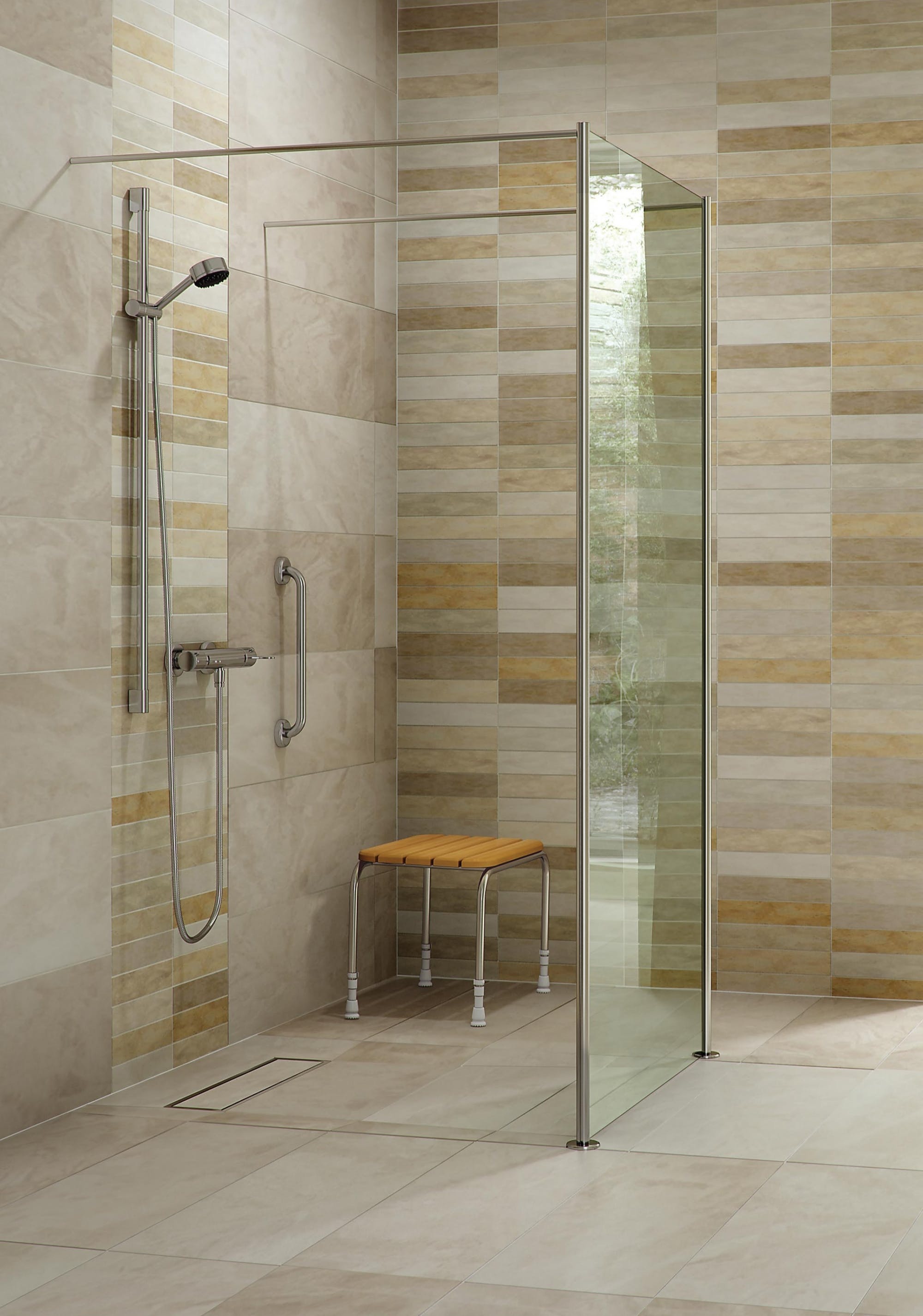
> DIY Potential
If you go for the higher cost of a bathroom and want to add in the smaller features such as the grab bars, shelves or basic features then you could do so later, to save on the initial cost of a walk-in shower.
Cost breakdown
In this part of our guide, we will be breaking down the cost of the different walk-in showers, to help you a real idea of how much it will cost to have one fit and installed.
> Standard walk-in shower (walk-in accessible shower)
A standard acrylic shower (walk-in accessible shower), full installation costs between £1,500 - £3,000 while a fitted tiled walk-in shower is slightly high in price, costing typically between £2,000 - £5,000.
> Barrier-free walk-in shower (level access shower)
The level access shower tray with the anti-slip resistant tray placed underneath the floor is higher in cost in both acrylic and tile materials, with the acrylic starting at £2,500 and rising to around £5,000 in comparison to the tiled level access shower starting at £3,000 going up to £7,000.
> Zero-threshold walk-in wet room (accessible wet floor shower)
As for the accessible shower, it is between £3,500 and £8,000 for an acrylic installation and for tiling £4,000 and £10,000.
> Walk-in wet room (modern accessible wet floor shower)
For a walk-in wet room installation, individuals can expect to pay between £5,000 and £12,000 for a basic acrylic installation but that figure jumps for a luxury (tiled) fitting starting from £8,000 and jumping to £20,000 + for a walk-in accessible wet floor shower.
Walk-in shower labour costs
Now when it comes to determining the labour costs of a walk-in shower there are a few elements that are involved.
Installation labour
Installing a standard (walk-in accessible shower) without any complexities is usually around £1,000 to £1,500.
For the more complex projects such as the mobility wet room, and accessible wet floor shower) the labour cost goes up due to the plumbing work involved in the project. Costs between £1,500 and £3,000.
> Demolition and removal
The starting cost of removing a bathroom can begin at £300.
If you have a bathtub you can expect to pay for it removal between £250 and as much as £350.
Depending on which company/individual you opt for to remove your old bathroom, you could end up paying up to £650 and more for bathroom removal.
There could be an extra cost that comes with removing the bathroom, and that is usually the collection of its rubbish. This can start from as low as £75 and with a rubbish removal specialist.
> Plumbing alterations
The shower room refurbishment may need some plumbing work including some simple pipe adjustments costing from £300 - £500, and if it needs new lined or rerouting of the pipes it could cost a lot more in the region of £1,000 - £2,000+.
> Flooring and waterproofing
The standard bathroom/ shower room which can usually take around3-4 days can cost approximately £800 - £1200. For the luxury materials and custom tile designs, you can expect to pay more, with a starting price of around £1,500.
Recap of the key considerations for a walk-in shower
And there we have it, a complete breakdown and points to consider when you’re thinking of installing either an accessible or mobility walk-in shower.
The cornerstone of successfully renovating an accessible shower room is to carefully plan and have a budget.
Regardless of the budget, it is key to prioritise your safety, comfort, and accessibility, which is the main reason for the refurbishment.
.jpg?auto=compress%2Cformat&cs=strip&ixlib=php-1.1.0&s=7d0e76550cfadaf7b5deba410dbebebb)
In doing so, pick the shower solution that is most appropriate for them and will ensure they retain peace and independence.
You should also seek guidance from experts and health professionals such as mobility specialists will help you pick the right shower and accessible shower features.
Let us handle the entire project with our team of professionals
We have a team of experts in different departments that can not only walk you through the decision of choosing the most suitable shower solution for you, but we can also deliver it from design to installation, as part of our full project-managed service.
Book a free design appointment /
call us!
FAQ suggestions
What are some ways to make my existing bathroom more accessible without installing a walk-in shower?
Aside from refurbishing an entire shower to make it accessible, there are multiple ways to make it accessible by fitting accessible features such as: -
> Grab bars
> Shower seats
> Anti-slip vinyl flooring
These are a few of the popular features that can help an individual's bathroom space to be accessible. You could also consider them to be in contrasting colours to help with the visibility.
How can I save money on installing a walk-in shower without compromising safety or functionality?
Safety and its functionality are the keys for individuals as it will guarantee their protection whilst in the showering area reducing the risk of the individuals being harmed.
You could look to make simple installations like grab bars by yourself to save money. It would also be worth it to compare quotes from various contractors, and even grants for financial assistance programs, to see if you qualify for them.
How can I ensure I choose a reputable and qualified contractor for my walk-in shower installation?
Check for the accreditations and license that are specific to the bathroom modifications and the accessibility installation whilst doing your research.
Reading Google and Trustpilot reviews would help you to gauge their reputation of carrying out work.
Then it would be to contact them to see if they can provide you with estimations of a walk-in shower.
Once you have this information in hand you can then look compare.
Share this Post


.jpg?auto=compress%2Cformat&cs=strip&ixlib=php-1.1.0&s=fc20a023ff19e429a76e5b3972be311b)
.jpg?auto=compress%2Cformat&cs=strip&ixlib=php-1.1.0&s=cca089325a5e13ef565c60964c601458)



.jpg?auto=compress%2Cformat&cs=strip&ixlib=php-1.1.0&s=b7fa7aee79a7401427c148f7b060ccd0)
.jpg?auto=compress%2Cformat&cs=strip&ixlib=php-1.1.0&s=26b88d78e89f4f635685480b27383ca0)
.jpg?auto=compress%2Cformat&cs=strip&ixlib=php-1.1.0&s=94995546c0609a9c2c7de001aecc5d80)


.jpg?auto=compress%2Cformat&cs=strip&ixlib=php-1.1.0&s=7d0e76550cfadaf7b5deba410dbebebb)

